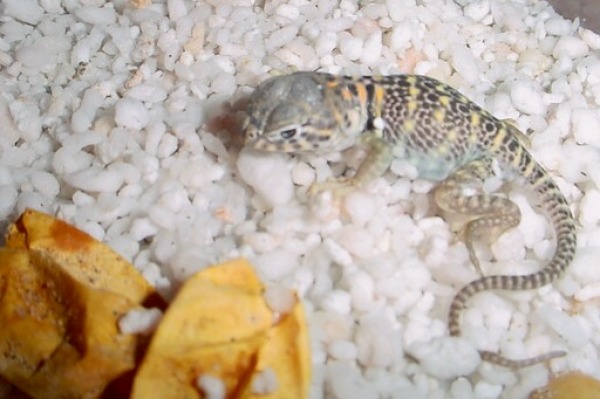All about Babies...
Teeny ickle bubbas....

Well breeding collared lizards is not a difficult task. As previously mentioned, lady collareds can breed from their first year, males need time to mature. If they have been brumated the chances are they will multiply. If they have not, well anything is possible. The mating ritual, as previously described begins with a kind of rain dance which the male performs to impress the female. He will bob his head rapidly at her, drag his butt around in the sand and often do push-ups to prove his worth.
Mating behaviour:

He will also bite her neck in an attempt to pin her down, which she may or may not accept. If she doesn't accept she might arch her back like a cat, roll over to escape, or even climb on him. Note how in the picture he has gripped her neck so as not to let her escape. The act itself is over within a matter of seconds, and from here on in your female will likely increase in weight and eat a lot more than usual. Gestation (the time it takes until she is ready to lay) is normally 21 to 28 days.
Provide a lay box
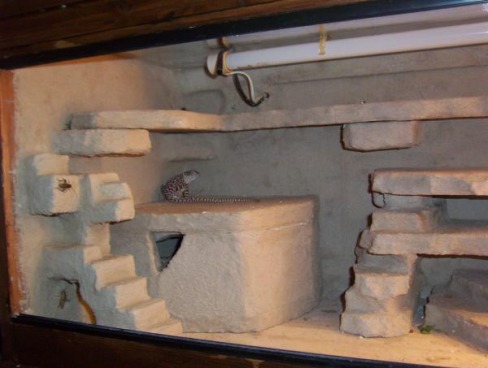
Importantly, your lady will need somewhere she feels safe to be able to lay her eggs in. Collareds are sensible enough to lay their eggs somewhere they dont think they are likely to be found by predators, so naturally they bury them. A lay box doesnt need to be a complicated affair. I started out with two bricks laid in the corner to form a square shape, half filled the "box" with damp sand and covered with a piece of slate, open at one end to allow her access. Some folk use big ice cream tubs with a hole cut in the side, I made mine pictured here to match the fake rock theme of my viv.It lifts out, and the lid sits snugly in the top, it doubles as a hide when not being laid in too, I leave mine in there all year round.
What Next??

Well she's eating more, she's probably a little more skittish than normal, and is going to start looking bigger. Quite often in the later weeks you may be able to literally see egg bumps sticking out, it's a very peculiar sight! She needs a lot of calcium to produce healthy eggs, so I dust their bugs daily with the usual calcium and vitamin powder.
My lay box normally contains a mixture of damp sand and coarse vermiculite. If you know your lizards have mated, go buy yourself a bag of coarse vermiculite from the garden centre or reptile shop. Mix it 3 parts play sand 1 part vermiculite, and add water so that it binds but is not soaked and put it in your lay box at the earliest opportunity. She might dig in there, look elsewhere and come back to it but you should leave her to it.
You also need to soak some vermic on its own for a minute or two, SQUEEZE it hard to get rid of any excess moisture, and pop it in a tub ready to sit your eggs in. I use an incubator because tend to have a lot of eggs, but you could make one easily enough, here is a link to a helpful page, you might need to join RFUK to view it. Alternatively just keep your eggs in the tub with a lid on at room temperature, just be sure they dont drop below low 70's or go above 90.
Hopefully you will have counted 21 days from the date she mated, or from the date she developed her orange bars if you don't know when the mating occured. This is a roughly the earliest date she will lay, but I've had one go 35 days. The less you disturb her the better. She might go into her laybox and not come out for a few days, she might bury herself, get sand in her eyes and appear very sleepy, but the trick is to remember, this is what happens, and so she should be left alone. I tend to peek in on mine in the afternoon to make sure she is ok. If she has and is still busy burying them, I tend to leave her to it until she is out the box of her own accord. The eggs arent likely to come to any harm if you have put the lay box away from the heat source, and the sand/moisture will keep them cool.
Once she is out, I generally feed her, take her out of the viv, and place her somewhere she can't see me taking her eggs momentarily. THen I remove the laybox, grab a plastic spoon, big tub and a paintbrush, and start the search for her eggs.
Rubbery, fresh eggs!!

I brush GENTLY through the sand bit by bit with the paintbrush, lifting the parts I have checked with the spoon into the spare tub, until I find where they are.
EGGS ARE COVERED IN A PRETECTIVE BARRIER THAT PREVENTS MOULD/ROTTING. For this reason I dont like to touch them with my bare hands. You may or may not see inder the shell of your eggs a pink mass which is the nucleus. Some people place their eggs in the tub with the "bullseye" facing up (pictured here). Personally I lay them exactly as I found them. I pick the eggs up one by one using the spoon and place in the tub of vermiculite. Then put all the sand back, put the lay box back where you found it, and put mom in her viv, she should be none the wiser.
The waiting game.....
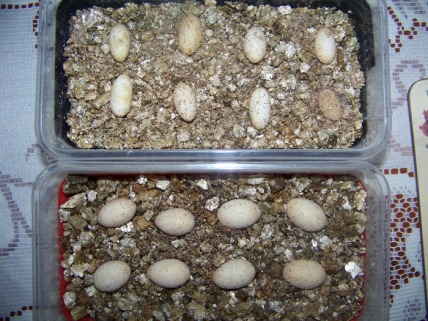
So now you have your eggs in your tub of vermiculite (I just use a cricket tub and cover half the air slats with electric tape, you have put the lid on, and have placed them in your incubator or warm spot. Now you need to sit tight and hang fire for at least 45 days. My Eastern eggs incubated at 85 degrees usually take about 56 days to hatch, cooler eggs will take longer, higher temps will be generally a little quicker. I have found the longer they take, generally the bigger the babies. Bigger babies are stronger babies too. You will notice that the eggs in the tub at the bottom of this picture are plumper, they are about 30 days more mature than the freshly laid ones in the tub above.
The reason they sit on top of the vermic instead of being buried in it is because they are porous and need air /moisture too. IF the eggs become too wet and/or humidity is too high, they might lose their anti-mould barrier and become mouldy. Taking the lid off for a while and sprinkling with a very fine layer of athlete's foot powder should kill the mould and prevent it from suffocating the egg too. Be careful not to suffocate the egg with the powder though, and only use if your egg is mouldy.
If eggs become dehydrated they will dent, and look like they are beginning to collapse. In this case I use a pipette to drip water around the edges of the tub taking care not to drip water on the eggs. It might take a few days for the eggs to plump back up, if not add a little more water again.
What's happening inside the egg?
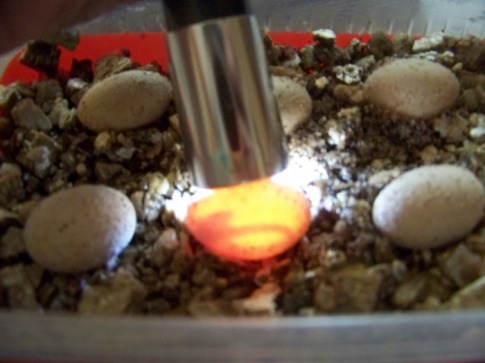
Well depending on how long the eggs had been laid, you may or may not have seen a pink "bullseye" inside if you found them before the shell had hardened. This is the nucleus, and from it within a quick period of time blood vessels will emerge, spreading around the inside of the egg, through the yolk. The Yolk becomes a yellowish, peachy solid mass much like blancmange, and on the outside of this mass the baby develops. He feeds from the yolk through his bellybutton, and will be fully formed within a few weeks. Then he grows bigger and bigger, feeding off his egg-sac until he is ready to hatch.
The candling of this egg shows you the size of a baby at about 28 days. It's an awesome photo!! The babies react to the light, so you shouldnt do this more than once or twice if at all, and especially not in the later stages.
My eggs should be hatching any day now..... what do I do??
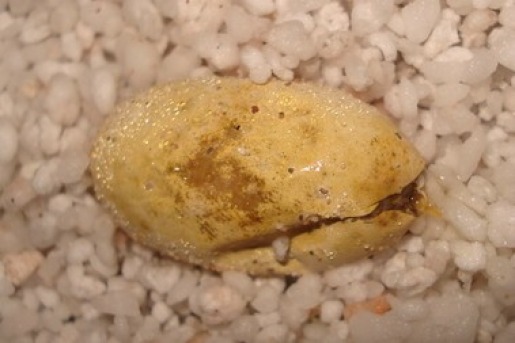
The simple answer to this is to watch and wait. You might notice that the eggs have begun to sweat. This doesnt always happen however so dont worry if they don't. They may also look like they are collapsing, or developing dimples in them. What is really happening is the baby inside has consumed most of the yolk from his egg sac, and is dispelling the fluid he is growing in, enabling him to wriggle about and use his egg tooth and break out of his sleeping bag. Often you will find one minute the egg looks exactly the same as it has every day for the last month and a half, then ten minutes later you find a crumpled brown bit of wrinkly looking rubber in your tub, and a sticky wet baby hiding in the corner hissing at you. Other times you might notice a little slit in one end of the egg, followed by a little wet nose, an hour later an eyeball, another hour later one leg, and several hours later he's out. They vary so much in the time they take to break free, the important thing is to never interfere. Let nature take its course and remember that a butterfly helped out of his cocoon will never fly.
OK so they've hatched... what do I do now?

Well your babies may still have small yolk sacs attached to their tummies. When this is the case I tend to leave them in the vermic tub until it's been absorbed for several reasons: 1) they can literally trip over it if it's still quite big, and vermic is moist and wet, perfect cushioning! And 2) I worry incase it dries and sticks to the paper towel. Once its gone, or if they hatch with no yolk, I CAREFULLY move them into a 2ft vivarium which is heated and lit exactly the same as a regular adult viv, the only exception being NO SAND. They probably won't eat for a few days because they are still feeding off their yolk, and gaining some strength, but I usually try them with a few small crickets after two or three days. A general rule of thumb is to not feed them anything any bigger than the size of the gap between their eyes!
Baby collareds are usually only a gram or two when they hatch, but they grow incredibly quickly. They normally are running around like whippets within a few days have their first shed after a few weeks. I don't like to re-home mine until they are 4 to 6 weeks, by which time they are big enough to sex too.
